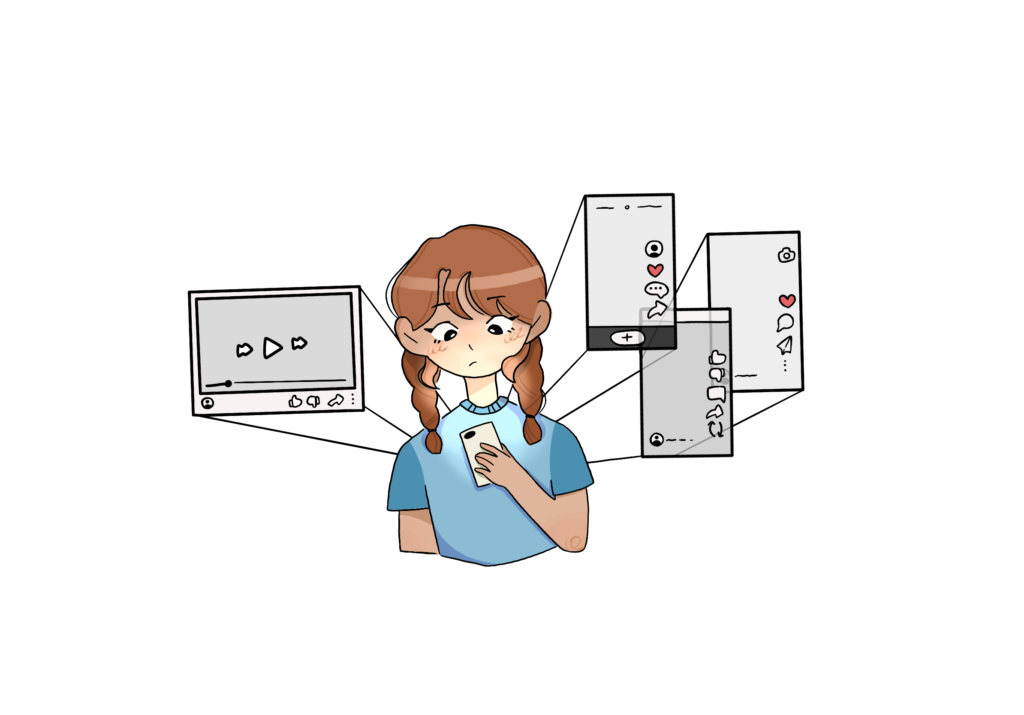
In the past few years, TikTok has risen to popularity through its short form content lasting typically between 15-30 seconds, tailored to the user’s interests through an algorithm.
Freshman Amelia Draffen comments on the benefits of brevity in TikTok videos.
“I can watch a bunch of different types of videos in a shorter amount of time,” Draffen said. “I don’t have to sit down and watch an hour or two [for a] longer movie, or a 20 minute video.”
TikTok became popular in the United States during the COVID-19 pandemic, and reached its highest number of downloads per quarter during early 2021, according to the data platform Statista. It was during this time that senior Arianna Koop began using TikTok.
“I started using [TikTok] a lot more [after] COVID because we were at home a lot,” Koop said. “I got used to scrolling.”
She believes that the isolation and resulting boredom during the lockdown was what drew many people to TikTok.
Since its success, TikTok’s short form content has been replicated by other media platforms. In Aug. 2020, Instagram launched Reels, and in September, YouTube launched YouTube Shorts. The following November, Snapchat released its short video channel, “Spotlight,” and Facebook introduced its own “Reels” feature for users in the United States in Sept. 2021.
Adding short form video features boosted the revenue of these companies. In July, Facebook CEO Mark Zuckerberg announced that Meta is projected to make $10 billion from Instagram and Facebook Reels in 2023. TikTok itself, which earned $9.9 billion in 2022, is forecasted to haul in $13.2 billion this year.
However, some students prefer watching long form content.
“[Short form videos] go into a topic without really explaining anything,” said sophomore Bradley Lum, who avoids watching short form content. “They repeat themselves over and over again.”
Senior Evan Wang also acknowledges that long form content can be more informative.
“Short form content [can] be a little more entertaining,” Wang said. “[However], you can learn more with long [form] content.”
Short form content is often regarded as more addictive. Draffen often gets pulled into watching too many TikToks.
“[When videos are longer,] it’s easier to stop,” Draffen said. “But with TikTok you can … scroll, and keep on watching.”
On one occasion, this has impacted her academics.
“I kept on scrolling when I was supposed to do homework,” Draffen said. “[So] I didn’t get a good grade on an assignment.”
Senior Adele Hsu, who prefers long form content, sees how short form content is formatted as dangerous.
“The act of scrolling itself is addictive,” Hsu said.
Watching short form content can also reduce viewers’ attention spans. Freshman Isaac Cheung, an avid consumer of YouTube Shorts has also noticed this.
“My attention span used to be longer [but] now, I cannot focus on anything,” Cheung said.
Hsu discussed experiencing similar side effects.
“I’ve noticed that especially with my homework, I need to be watching something at the same time or I need… a little distraction every five minutes,” Hsu said.
With the rising popularity of short videos, some content creators have had to adjust to the shift as well.
“I have seen a lot of videos go from [being] longer [to being] compressed into short videos because [people’s attention spans] are [currently] really low,” Cheung said.
Koop believes that the spread of short form content have had a negative impact.
“I think it’s good to have distractions, but I think there is a point where it gets to be too much,” Koop said.
However, some see advantages to consuming short form content.
“I’ve had a lot of fun learning the dances on TikTok,” said junior Hanna Quanbeck. “And with my friends, it’s a fun thing to do.”
Regardless of the effects, many people still enjoy short form content. Wang, who prefers longer YouTube videos, also watches TikToks to alleviate stress.
“Sometimes [watching TikToks] can be distracting,” Wang said. “But I think [that] if you manage your time correctly, [it can be beneficial].”
Having captured the internet in 2018, TikTok’s influence, even in 2023, is apparent, having spurred the rise of short-form content across social media. However, debate remains on the effects of such a change




